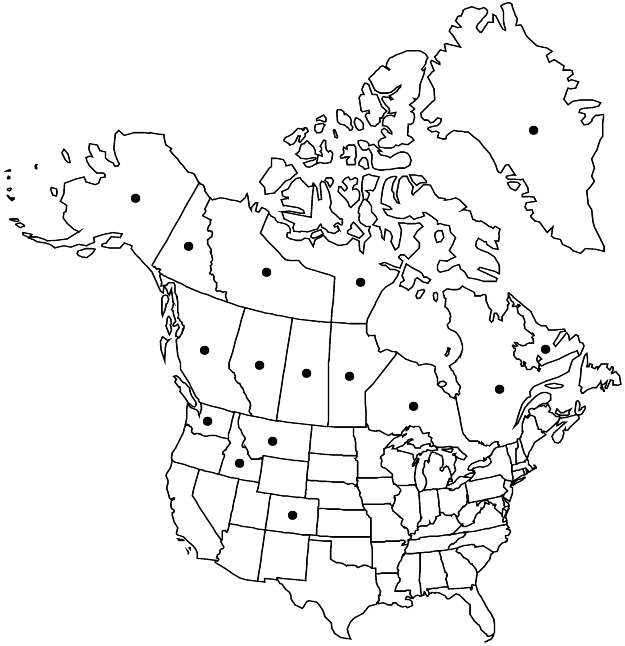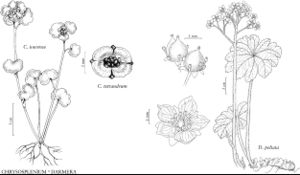Difference between revisions of "Chrysosplenium tetrandrum"
Bot. Not. 1858: 193. 1859 ,.
FNA>Volume Importer |
imported>Volume Importer |
||
| (6 intermediate revisions by 2 users not shown) | |||
| Line 7: | Line 7: | ||
}} | }} | ||
|common_names=Northern golden-saxifrage;dorine à quatre étamines | |common_names=Northern golden-saxifrage;dorine à quatre étamines | ||
| + | |special_status={{Treatment/ID/Special_status | ||
| + | |code=F | ||
| + | |label=Illustrated | ||
| + | }} | ||
|basionyms= | |basionyms= | ||
|synonyms={{Treatment/ID/Synonym | |synonyms={{Treatment/ID/Synonym | ||
|name=Chrysosplenium alternifolium subsp. tetrandrum | |name=Chrysosplenium alternifolium subsp. tetrandrum | ||
|authority=(Th. Fries) Hultén | |authority=(Th. Fries) Hultén | ||
| + | |rank=subspecies | ||
}} | }} | ||
|hierarchy=Saxifragaceae;Chrysosplenium;Chrysosplenium tetrandrum | |hierarchy=Saxifragaceae;Chrysosplenium;Chrysosplenium tetrandrum | ||
| Line 26: | Line 31: | ||
|elevation=0-3300 m | |elevation=0-3300 m | ||
|distribution=Greenland;Alta.;B.C.;Man.;Nfld. and Labr. (Labr.);N.W.T.;Nunavut;Ont.;Que.;Sask.;Yukon;Alaska;Colo.;Idaho;Mont.;Wash.;n Eurasia. | |distribution=Greenland;Alta.;B.C.;Man.;Nfld. and Labr. (Labr.);N.W.T.;Nunavut;Ont.;Que.;Sask.;Yukon;Alaska;Colo.;Idaho;Mont.;Wash.;n Eurasia. | ||
| − | |discussion=<p>As treated here, Chrysosplenium tetrandrum is circumpolar. In North America, disjunct populations occur in subalpine and alpine habitats in the Bitterroot Range of Idaho and Montana, and in the Front Range of Colorado. Some specimens from northern Europe and the Russian Far East that have been referred to C. alternifolium appear to be morphologically indistinguishable from C. tetrandrum.</p> | + | |discussion=<p>As treated here, <i>Chrysosplenium tetrandrum</i> is circumpolar. In North America, disjunct populations occur in subalpine and alpine habitats in the Bitterroot Range of Idaho and Montana, and in the Front Range of Colorado. Some specimens from northern Europe and the Russian Far East that have been referred to C. alternifolium appear to be morphologically indistinguishable from <i>C. tetrandrum</i>.</p> |
|tables= | |tables= | ||
|references= | |references= | ||
| Line 35: | Line 40: | ||
-->{{#Taxon: | -->{{#Taxon: | ||
name=Chrysosplenium tetrandrum | name=Chrysosplenium tetrandrum | ||
| − | |||
|authority=Th. Fries | |authority=Th. Fries | ||
|rank=species | |rank=species | ||
| Line 49: | Line 53: | ||
|publication title=Bot. Not. | |publication title=Bot. Not. | ||
|publication year= | |publication year= | ||
| − | |special status= | + | |special status=Illustrated |
| − | |source xml=https:// | + | |source xml=https://bitbucket.org/aafc-mbb/fna-data-curation/src/2e0870ddd59836b60bcf96646a41e87ea5a5943a/coarse_grained_fna_xml/V8/V8_144.xml |
|genus=Chrysosplenium | |genus=Chrysosplenium | ||
|species=Chrysosplenium tetrandrum | |species=Chrysosplenium tetrandrum | ||
Latest revision as of 22:41, 5 November 2020
Stolons white, 0.3–1 mm diam., sparsely villous, hairs white, reddish brown, or purplish. Flowering stems erect, branching in distal 1/6–1/3(–1/2), (1.2–)3–21 cm, glabrous or sparsely villous, especially proximally, hairs white or reddish brown. Leaves alternate, membranous or fleshy. Stolon leaves: petiole 12–55 mm, usually sparsely villous, sometimes glabrous, hairs white or reddish brown; blade usually depressed-ovate to reniform, sometimes nearly round, 3–14 × 5–18 mm, base cordate, margins 5–7-crenate, not purple-spotted, glabrous or sparsely ciliate, hairs white, surfaces glabrous or sparsely villous adaxially, hairs usually white, rarely purple. Cauline leaves 1–3(–4); petiole (2–)4–20(–31) mm, glabrous or sparsely villous proximally, hairs white or reddish brown, sometimes purplish; blade depressed-ovate, flabellate, or reniform, 3–9 × 4–13 mm, base truncate to cuneate or cordate, margins 3–7-crenate, glabrous, surfaces glabrous. Inflorescences terminal, (2–)3–15-flowered, compact cymes; bracts green, usually purple-spotted, foliaceous, ovate to depressed-ovate or flabellate, 2–9 × 3–12 mm, margins subentire or 3–5-crenate. Pedicels absent or 0.1–1.5 mm. Flowers: hypanthium green or greenish yellow, usually not purple-spotted, rarely purple-spotted distally, turbinate to campanulate, 1–2.2 × 1.2–2.1 mm, glabrous; sepals usually erect, sometimes spreading, usually green, rarely yellow, usually purple-spotted throughout or distally, rarely not purple-spotted, ovate to broadly ovate or depressed-ovate, 0.8–1.5 × 0.8–1.7 mm, apex obtuse to rounded; nectary disc apparently absent; stamens (3–)4, 0.3–0.4 mm; anthers yellow, 0.1–0.3 × 0.1–0.3 mm; styles 0.2–0.3 mm. Seeds (6–)15–40, reddish brown, ovoid to ellipsoid, 0.5–0.8 mm, glabrous. 2n = 24.
Phenology: Flowering May–Aug.
Habitat: Marshy ground, muddy stream banks and shorelines, mossy seeps, bogs, fens
Elevation: 0-3300 m
Distribution

Greenland, Alta., B.C., Man., Nfld. and Labr. (Labr.), N.W.T., Nunavut, Ont., Que., Sask., Yukon, Alaska, Colo., Idaho, Mont., Wash., n Eurasia.
Discussion
As treated here, Chrysosplenium tetrandrum is circumpolar. In North America, disjunct populations occur in subalpine and alpine habitats in the Bitterroot Range of Idaho and Montana, and in the Front Range of Colorado. Some specimens from northern Europe and the Russian Far East that have been referred to C. alternifolium appear to be morphologically indistinguishable from C. tetrandrum.
Selected References
None.
